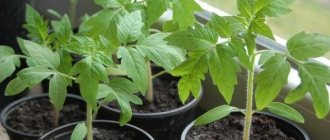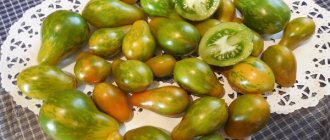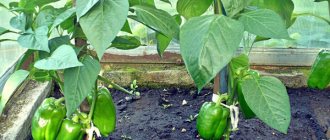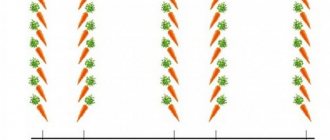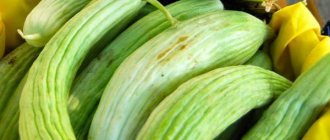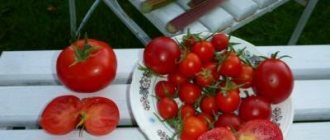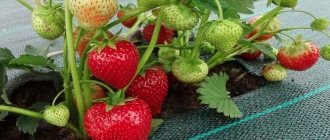The initial hassle associated with growing seedlings and caring for permanently planted tomatoes is far behind us. The plants have completely entered the fruiting phase. Today we’ll talk about proper watering of tomatoes in the second half of the season, when they stop actively growing green mass and enter the fruiting phase.
Read on dacha6.ru:
Treatment of tomatoes with Metronidazole against late blight
When to pick tomatoes in a greenhouse for ripening in the Moscow region
Everyone knows that moisture plays a key role in the formation of fruits. Tomatoes need to be watered regularly, while avoiding waterlogging of the soil and air.
Heavy watering in June is often caused by heat, low rainfall that month and increased vegetative growth. It is also important that all the necessary nutrients and minerals from the soil necessary for the growth and development of tomatoes are obtained in dissolved form from the soil along with water.
During this period, the surest guideline for a summer resident is the drying out of the top layer of soil. After each watering, do not forget to loosen the surface layer of soil without deep digging, so as not to damage the delicate roots.
Liquid fertilizers are extremely important. In the first half of June, it is mainly a urea solution (1 tbsp per 10 liters of water), and in the second half, when the plants are actively flowering, in addition to nitrogen, add potassium fertilizers to form a good ovary.
Features of feeding
It is easier to care for tomatoes in a greenhouse. In August, there is no longer a need to feed tomatoes, although foliar feeding can be done to speed up the ripening of fruits. A solution is prepared from superphosphate (2 tbsp) and water (2 l), left for 24 hours, then water (9 l) is added. The plant itself and the fruits should be sprayed with the resulting solution.
Some problems when growing tomatoes arise from a lack of balanced nutrition. In August, the need for potassium in tomatoes grown in greenhouses doubles , so it is recommended to add potassium sulfate or wood ash.
A lack of phosphorus is accompanied by a purple hue and a decrease in leaf size. This can be replenished by adding chicken manure. If there is a lack of nitrogen, the leaves become lighter; it is necessary to feed the plants with urea.
Trim the tops of tall bushes
To ensure that all the energy of the bush goes towards the formation of fruits, cut off the tops of tall tomatoes. The cut should be made above the second leaf after the upper raceme with ovaries or inflorescences. Be sure to disinfect the tool before use.
- Tomatoes hit the roof of the greenhouse? It's time to stop them!
There are varieties of tall tomatoes for which a height of 2 m is not the limit. What to do with them if they have grown to the very ceiling?
Watering and forming a bush
In August, watering is limited: it is required only if the soil is dry. By this time, the tomatoes are well rooted, the roots grow deep into the soil and take moisture from there.
You need to water at the root (drip or regular method). Sprinkling is not recommended - air humidity increases, fruit set worse. It is necessary to regularly ventilate the greenhouse.
To obtain a good harvest, pinching of bushes is required. In August, it is necessary to continue removing additional shoots that appear in the axils of the leaves and interfere with the formation of fruits. They are removed without waiting until the length becomes more than 5 cm.
Those inflorescences that bloom in August most often do not have time to produce a good quality harvest. For this purpose, they are removed (tomatoes need 45 days to ripen).
After pinching the tops of tall bushes, small and late-set fruits will ripen faster.
You can find advice to speed up the ripening of tomatoes: cut the stem at a distance of 10 cm from the ground, insert a small piece of wooden stick into the resulting cut.
After food is supplied to the bush in limited quantities, the fruits will begin to ripen faster.
Such manipulation can be carried out only after all the fruits have formed.
In August, when caring for tomatoes, protection from diseases (late blight, fusarium, streak) is required . Starting from the 20th of August, it is recommended to stop watering: in the second half of the month, late blight begins to appear on the bushes; care consists of preventing its spread. All diseased leaves are cut off: the fruits will be able to ripen without them.
At the end of August, when the outside temperature is below +10 °C, you can remove fruits that have already gained sufficient weight, but have not yet turned red. This will prevent late blight.
The main symptom of fusarium is stunted plant growth. Treating the bushes with an infusion made from nettle and celandine will help to cope with the problem (taking 4.5 kg of each herb, pouring 40 liters of water over it and infusing it for 24 hours). The resulting solution is diluted with water (in a ratio of 1:5) and used for treatment at the rate of 1 liter of solution per 1 bush.
When stripes and streaks appear on the stem of tomatoes and dark spots form on the leaves, there is a high probability that the tomatoes are affected by a streak. This is a virus, the affected bushes must be removed, the remaining ones must be treated with a solution of potassium permanganate, followed by foliar feeding with microelements.
Water regularly
In August, tomatoes still need regular watering. There are no clear recommendations on the frequency of watering, since it depends on the composition of the soil and climatic conditions. And if at the beginning of the growing season the bushes need to be watered rarely, but abundantly, so that the root system develops well, then during the period of fruit ripening it is better to water not so abundantly, but often, especially if the weather is hot. Try not to allow the soil to dry out, alternating with excessive moisture, as this can lead to cracking of the fruit.
- Why tomatoes crack and how to avoid it
Cracking of tomatoes is not such a terrible scourge as, for example, late blight. However, it also causes the summer resident a lot of trouble.
After watering, windows and doors are left open in the greenhouse to reduce air humidity (it should not be higher than 65%). When the last fruits on the bushes begin to ripen, stop watering the tomatoes.
Caring for tomatoes in a greenhouse (video)
- Author: Sergey Vladimirov
Rate this article:
(0 votes, average: 0 out of 5)
Many farming enthusiasts complain that due to the greatly changed climate, tomatoes in open ground have begun to grow poorly. Intense heat dries out leaves and ovaries, hurricane winds break bushes, and heavy rains contribute to fungal diseases of tomatoes. If you are an avid gardener and are accustomed to growing vegetables yourself, then be sure to build a greenhouse on your property. It is in it that tomatoes grow well, but only if you care for them properly.
Remove stepchildren regularly
A large number of side shoots inhibits the ripening of fruits and thickens the bush, interferes with ventilation, which can lead to the development of various diseases. Therefore, periodically inspect the bushes and remove stepsons in a timely manner. However, if you have lost sight of some extra shoots, and they already have ovaries, then you should not remove them - you can limit yourself to pinching the top.
- How to properly pick tomatoes and whether you need to do it at all
Why shoot tomatoes, how to do it correctly and what will happen to the tomatoes if you don’t do shoots? Let's figure it out together!
Feeding tomatoes in greenhouses and open ground
Some of the problems in tomatoes may be due to unbalanced nutrition or the lack of necessary elements in it. Often, gardeners simply scatter fertilizers over the garden bed and work them into the soil with a rake. But with such feeding, the plants do not absorb most of the nutrients.
It is best to feed tomatoes with liquid fertilizers along furrows previously made between the rows. Before doing this, it is important not to forget to water the beds.
Fertilizers applied over spilled soil are better absorbed by plants
In August, the need for potassium in tomatoes doubles. Feed the bushes with wood ash (1 cup per 10 liters of water) or Kalimag fertilizer (10-12 g per 1 sq.m.).
If the tomato leaves become lighter, there is a lack of nitrogen. The situation will be corrected by watering with a urea solution (1 tablespoon per 10 liters of water). And if there is a lack of phosphorus (a sign - the leaves acquire a purple-violet hue), add superphosphate (2 tablespoons per 10 liters of water).
To ensure that tomatoes do not lag behind in growth, feed them with an infusion of bird droppings: 0.5 kg of dry chicken droppings, pour 10 liters of water, cover the container tightly with film and infuse the fertilizer for 3-5 days. Then dilute the infusion with water in a ratio of 1:20 and pour 1 liter under each plant.
In the intervals between root feedings, apply foliar feedings (on the leaves). For this, preparations such as Agricola, Multi-7, Microvit-11 or any complex fertilizer with microelements are suitable.
Mulch the beds
To retain moisture in the soil and avoid watering too often, mulch the bed. A layer of mulch also helps stabilize the temperature of the earth: it heats up slowly and cools down slowly, and does not overheat under the scorching rays of the sun. Under a layer of mulch, the soil becomes loose and airy, earthworms actively work in it, and beneficial soil microorganisms multiply.
If tomatoes are sick...
The appearance of dark spots on the leaves, as well as stripes and streaks on the stems, indicates infection with strik (a dangerous viral disease). Remove such bushes immediately and burn them to prevent the spread of the disease. Spray the remaining plants 2-3 times with a dark pink solution of potassium permanganate and spray the leaves with any fertilizer with microelements. At the first signs of late blight, treat the bushes with 1% Bordeaux mixture, copper sulfate (1 tablespoon per 10 liters of water) or folk remedies.
Don't make mistakes when growing tomatoes - and then your green pets will give you an unprecedented harvest.
Basic rules of watering
Proper care also includes ensuring systematic watering. The procedure is carried out exclusively at the root. The supply of water should occur using the standard or drip method.
It is not recommended to implement the rain principle; it will have an adverse effect on further flowering and fruit set of the crop. It is necessary to monitor air humidity to prevent the spread of fungal infections.
You will need:
What do cucumbers like? They will thank you for such care with a good harvest. Cucumbers are a difficult crop to grow in the garden, which requires special care when growing. They seem quite...
Features of watering tomatoes in beds
This method is popular among gardeners because it is simple and effective.
In a garden bed with tomato bushes planted in 2 rows, 3 ditches are made (along and between the rows). Place the irrigation hose in the groove, turn on the water and wait until the entire bed is completely filled with water. The framed area turns into a small lake at the end of watering. This technique allows the soil to be well saturated with moisture and provide the plant with comfortable growing conditions.
If you are wondering whether you need to water tomatoes in August, then low-growing varieties are irrigated less from the moment the fruits ripen, and closer to the middle of the month, watering stops altogether. This approach to irrigation makes it possible to achieve uniform ripening of tomatoes, prevent cracking of fruits, and damage to the crop by late blight and rampant spotting.
Protection against infections and pests
Closer to autumn, pest attacks are not so dangerous, but care must be taken about prevention and protection against diseases. Cool weather and rain are the best time for late blight, so gardeners need to be on alert in August.
Treatments help:
- Bordeaux mixture (1%);
- a solution of copper sulfate (a tablespoon per bucket of water);
- milk composition: take a liter of milk per bucket of water and add 15 drops of iodine.
Fusarium is dangerous, and spraying tomatoes with nettle infusion gives good results. 2 kg of crushed nettle are infused in 20 liters of water for 24 hours, then the infusion is filtered. Dilute 1:5 and treat plants leaf by leaf. Treating tomatoes with a strong solution of potassium permanganate helps prevent streaking (viral infection). Bushes affected by infections are immediately removed from the greenhouse or garden bed, and the soil is spilled with a solution of potassium permanganate or Fitosporin-M.
As you can see, you can’t leave tomatoes unattended in August. Proper agricultural technology will increase yields and extend the fruiting period of plants.
Accelerating the ripening of tomatoes Every gardener who grows tomatoes in a greenhouse wants to protect them from insidious greenhouse diseases for as long as possible. To do this, you have to use different techniques, incl. and accelerating fruit ripening. We have already looked at some of them before. First of all, this is the cultivation of super-early ripening varieties and hybrids, dense planting of these plants with their formation into only one stem, normalization of the number of brushes on the plant, pinching the tops of plants, limited use of nitrogen fertilizers, and preventive treatment of plants. And from the end of July, the size of the harvest is favorably affected by the regular removal of the lower aging and especially yellowed or disease-affected leaves. It is better to do this on a sunny morning so that the wound on the stem dries faster. By the time the fruit begins to ripen, all leaves up to the first cluster should be completely removed. From the first days of August, the timely removal of all emerging stepsons and limiting plant growth, especially in tall varieties, are no less important. To do this, 4–5 weeks before the end of the growing season, i.e. in early August, the growing points of the plants are pinched, leaving 2–3 leaves above the last inflorescence with already set fruits. Usually, all flower buds remaining at this point are also removed, because they will not have time to bear full fruit. Under our conditions, in a “typical” amateur unheated greenhouse, you can get up to 6–8 bunches of fruit from a plant, depending on the early maturity of the variety and the timing of planting. Simultaneously with pinching, it is also necessary to remove all inflorescences in the budding phase or immediately after flowering, since you will no longer get fruit from them, especially in early autumn. We should not forget that after pinching the tops of plants and stepsons quickly begin to grow again. When growing giant tomatoes, it is not enough to just form these plants; they require strictly rationing the number of ovaries in each cluster if you want to get large fruits. Usually, giants have 3 ovaries on the lower and middle hands, two ovaries above the middle ones, and one on the upper ones. With this adjustment of the number of fruits, the total mass of the crop increases, and the fruits become larger. You can, of course, not do this. In this case, you will get large fruits, but not giants. The ripening of a mature crop is significantly accelerated if the clusters with fruits are turned toward the sun. This “folk” technique is especially effective for super-early ripening varieties. In this case, there should not be a single leaf under the first cluster, and under the clusters of large-fruited varieties it is necessary to place supports or hang them in a “hammock”.
Preventive measures Every gardener knows that diseases cause great harm to the tomato crop, especially in a greenhouse. Therefore, to avoid tomato diseases, regular preventive treatment of plants is necessary. It is advisable to carry out at least two preventative sprayings for super-early and early-ripening varieties and at least three for tall varieties and giants. But, starting from the beginning of August, such spraying should be done only with garlic infusion. Remember well the good old rule - after spraying with poisons, fruits should not be eaten for 3 weeks. To prepare garlic infusion, garlic heads, leaves, arrows, and roots are passed through a meat grinder. One faceted glass of this crushed mass is poured with 1 liter of raw water and left for 24 hours. Then the solution is filtered, water is added to 10 liters and the plants are sprayed. Garlic phytoncides destroy pathogens of fungal diseases. For better adhesion of the liquid to the plant, you can add 1 tbsp per 10 liters of solution. a spoonful of washing powder or soap. It is also advisable, starting from the end of July, to spray the plants twice with a pink solution of potassium permanganate. Spraying is especially effective in the evening after a hot day. And if the plants do get sick, then we must not forget about the abundance of the most modern means for combating diseases. Do not forget the golden rule of growing tomatoes in a greenhouse - until the last fruits are removed from the bush, it is necessary to spray the plants with biological fungicides (Alirin, Gamair, Fitosporin), which are equivalent in effect to garlic. And when night cold snaps and the first signs of late blight appear, the entire crop must be harvested immediately.
Do I need to tear up the roots at the end of summer? To speed up the ripening of fruits, some gardeners also use partial tearing of the roots, especially in tall varieties. To do this, the plant is carefully pulled up by the lower part of the stem. The roots are slightly torn, the plant’s nutrition is somewhat limited, and this speeds up the ripening of the fruit. But such a procedure must be carried out no earlier than the end of the first ten days of August, otherwise there will be many small fruits that will not have time to grow. This technique, of course, is not scientific, but barbaric, although in this case the fruits actually ripen faster, but their total mass, after you have torn the roots a little, practically does not increase. Therefore, using this technique when there are a lot of small, not yet formed fruits on the plant, you will significantly lose in the harvest. But the most effective way to speed up the filling and ripening of fruits, of course, is still the timely collection of mature fruits, brown and green, and placing them for ripening (ripening).
Harvesting You cannot be late in harvesting tomatoes. Sometimes the beginning of autumn can be so warm and sunny that you simply can’t believe that autumn has already arrived. But it is precisely at this time that you need to be especially attentive to weather forecasts and monitor the approach of cold weather. After all, autumn nights are getting colder, and there is often cold dew. That is why it is very important to remove tomatoes from the bushes before the air temperature drops below +8°C at night. Some authors in their articles sometimes indicate lower temperatures (up to +4°C), but this is doubtful, and you should not risk your tomato harvest. Fruits should be harvested in warm weather, when there are no drops of moisture on them. It is best to do this in the morning, when the tomatoes are at their most resilient and of the highest quality. There are three degrees of ripeness of fruits - green ripe (whitened), blanched and ripe. Green-ripe fruits have already reached normal size and shape, their seeds are already fully formed. When ripened, such fruits acquire the taste and color characteristic of the variety. Do not confuse green ripe (whitened) fruits, which are green but fully formed, and green tomatoes, which are in the growing stage. These teenage fruits, after being picked from the bush, also gradually ripen, but they have a completely different taste. Green-ripe fruits are good for long-term storage and transportation over long distances. In blanzhe fruits, a pink color appears near the stalk; when cut, the flesh is already pink or yellowish-golden in color. To taste they are already suitable for consumption. Blazing tomatoes also withstand transportation well. Ripe fruits have a taste and color characteristic of this variety. Ripe tomatoes of most varieties, as a rule, are not suitable for transportation over long distances. Many years of experience of gardeners confirms that fruits, especially at the end of summer and beginning of autumn, should be picked from the bushes only when they are ripe or green. This will allow the remaining fruits to be well-ripened by the time they are harvested, which will entirely depend on the weather. If there are a lot of ripe fruits hanging on a plant, then their overall yield is significantly reduced. In addition, harvesting green-ripe fruits from the plant almost completely eliminates late blight, which is especially dangerous in the second half of summer. When harvesting tomatoes, you must carefully protect them from mechanical damage; you must not throw them or crush them, as damaged tomatoes quickly deteriorate.
It is almost impossible to imagine garden beds without tomatoes. Our people love to eat both fresh and canned tomatoes, and tomato juice goes great. August is the hottest time for tomatoes. They bear fruit, while continuing to grow, bloom and form new ovaries. Can you imagine how much strength your plants need for this? In this article we will tell you what to feed tomatoes in August and how to care for them to help them produce a harvest longer.
From the article you will learn:
- Take care of protection from diseases We also recommend reading:
Central rules
If we summarize the basic principles on how to water tomatoes in a greenhouse, we will get just a few central rules that must be followed without fail:
- Unlike growing in open ground, tomatoes in a polycarbonate greenhouse are watered less frequently - no more than twice a week.
- Each tomato bush requires approximately four liters of water.
- It is better to pour water at the root, without affecting the leaves and stem.
- The best time for watering is the time of minimal solar activity (morning, evening).
Normal tomato growth requires maintaining a humidity level near the soil of around 90%, and near the bush - up to 48%. Such differentiation will protect the plant from most viral diseases and at the same time maintain sufficient moisture.
The choice of how often to water tomatoes in a greenhouse may also depend on the variety, the characteristics of the local climate and soil, and the watering method itself.
Remove excess leaves and color in a timely manner
We are not talking about damaged, but about completely healthy, but extra leaves during this period. During fruiting and flowering of a tomato, the plant should devote all its energy to these processes, and not to ensuring the vital activity of a significant amount of green mass.
When getting rid of excess foliage, do not overdo it. It is enough to remove two or three leaves on each branch once a week. Only the foliage underneath the flower is removed, not above it. It is ideal when, during fruiting, the fruit outermost from the stem is completely devoid of leaves from below.
Don't be afraid to get rid of excess color either. Calculate whether it will have time to turn into a full-fledged tomato, if at least 45 days must pass before this moment. If the chances for this are clearly not enough, say goodbye to the excess color before the ovaries form. They will only draw strength from the bushes.
